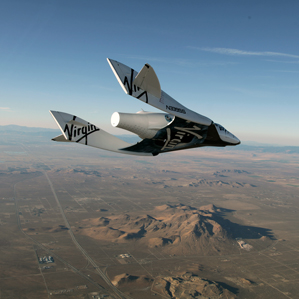Virgin Galactic Tragedy May Mean New Space Tourism Rules
The investigation into the Virgin Galactic accident has yet to find a cause, but the FAA will consider new regulations for commercial space travel.

Congress has avoided placing regulations on commercial spaceflight in order to encourage people to enter the business.
When Virgin Galactic’s SpaceShip Two disintegrated over the skies of Southern California last week, killing one test pilot and injuring another, it highlighted one of the fundamental problems facing space tourism—the lack of regulations governing the business of blasting paying members of the public into orbit.
The U.S. Federal Aviation Administration already has a minimal regulatory framework for commercial spaceflight. Companies have to get test permits, for example. But in an effort to spur on the development of the commercial space industry, Congress imposed a moratorium on burdening the fledgling sector with additional red tape back in 2004, with the Commercial Space Launch Amendments Act. And in 2012, Congress extended the measure to October 1, 2015.
“It was believed that this would support the industry by not having regulations to act as barriers,” said Joanne Irene Gabrynowicz, editor-in-chief of the Journal of Space Law and visiting professor at the Beijing Institute of Technology School of Law. “The moratorium would be in place until a certain date or the event of the first death. Unfortunately, the first death has now occurred and the FAA will likely revisit the need for regulations, if any.”
That death occurred on October 31, when Michael Alsbury, a test pilot for Scaled Composites, the aerospace company developing an orbital vehicle for Virgin Galactic, was killed during a rocket-powered test flight. Fellow test pilot Peter Siebold was also injured after managing to escape from the vehicle as it broke up at an altitude of around 15,000 meters (50,000 feet).
The National Transportation Safety Board is currently investigating the accident. Preliminary evidence shows that the rocket motor, which was initially suspected as the cause of the crash, was not to blame. A statement released by Virgin Galactic, citing the NTSB investigation, noted the intact engine and rocket propulsion fuel tanks. “This definitively dismisses the premature and inaccurate speculation that the problem was related to the engine or the fuel,” the statement read.
The NTSB’s focus is on SpaceShip Two’s unique feathering mechanism, which moves the spacecraft’s wing booms into the vehicle’s reëntry configuration. “The NTSB indicated that the lock/unlock lever was pulled prematurely based on recorded speed at the time,” reads the Virgin Galactic statement. “They have suggested that subsequent aerodynamic forces then deployed the feathering mechanism, which resulted in the in-flight separation of the wings and vehicle.”
Despite the tragic accident, it is unclear if the accident will spur any new regulations, says Henry Hertzfeld, a lawyer and research professor of space policy at George Washington University. “I really think it’s too early to comment on that.”
Aviation accidents, especially during highly sophisticated developmental test programs, are not that uncommon, says Hertzfeld. The issue is how many test flights are needed before the spacecraft can be certified to carry passengers. “The bottom-line question is how many test flights do you need?” Hertzfeld says. “I don’t think anyone can put a finger on that.”
Legally, absent any further regulation, passengers can do what they like if they are aware of the danger. “People climb Everest,” Hertzfeld says. “People do those types of things because they are crazy, stupid, or thrill-seeking.”